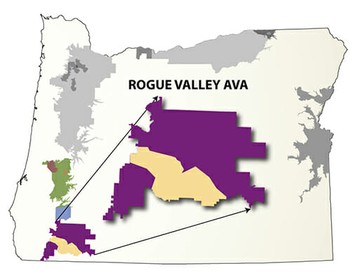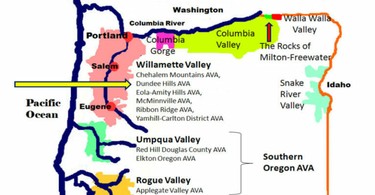The Valleys of Oregon Wine: Willamette, Rogue, and more
There’s nothing flat about West Coast wine. California and Oregon wine country is characterized by mountains and valleys that keep our microclimates interesting.
Napa Valley may be the USA’s most famous wine region and the Willamette Valley is Oregon’s… so far. Oregon is so much more than just Pinot Noir. Read on to discover what you should drink from where.
Wine Region Oregon
Rogue Valley
 Winkler Index Zone: II in a cool year, IV in a hot year, and generally in between.
Winkler Index Zone: II in a cool year, IV in a hot year, and generally in between.
Soils: Extremely varied, generally shallow and nutrient-poor.
Old World Wine Region Twins: Rioja, Rhône Valley.
What You Should Drink: Tempranillo, Syrah, Viognier, Malbec.
What Else is Here: World’s best cheese 2019 (Rogue Creamery Blue), white water rafting, pears (Harry & David), mountain biking, Oregon Shakespeare Festival
The Rogue Valley (home to Resistance Wine Co) is actually three valleys: Bear Creek, Applegate, and Illinois. All three of these wine regions in Oregon are just north of the California border, inland from the Pacific Ocean and part of the Siskiyou mountains. The Applegate Valley is its own AVA (American Viticultural Area, which is a federal designation). It wouldn’t be a surprise if other subregions of the Rogue Valley were to petition for their own Southern Oregon AVAs in the future due to their distinctive features.
The Illinois Valley Oregon wine region is relatively cool and Bear Creek Valley bakes in the summer. All are dry- there is almost no measurable rainfall between June and September, and most years find us at varying levels of drought.
Within each valley, elevation and aspect have a big impact on each vineyard’s microclimate. The Rogue River, Applegate River and Illinois River each impact temperatures and regional climates. Higher elevation vineyards receive more direct, concentrated sunlight, which translates into tougher skinned grapes with more tannin development – great for producing age-worthy red wines like Syrah, Tempranillo, Cabernet Sauvignon or Malbec.
High elevation sites also generally benefit from large diurnal temperature swings (i.e., the difference in day-to-night temperatures), which contribute to slow sugar accumulation and allow the grapes more “hang time” to develop riper flavors prior to harvest.
Flatter, lower-elevation sites are good for early-ripening varieties, thinner-skinned varieties, and rootstocks that thrive with higher soil moisture like Sauvignon Blanc, Cabernet Franc and Pinot Gris. Southern- and western-facing hillsides get more direct sunlight and do so earlier in the spring; northern- and eastern-facing slopes have less direct exposure. The valley floor is hot during the day and cool at night producing some great Rogue Valley wine.
Basically, we can find a site in the Rogue Valley to grow just about any grape variety. And because the Rogue Valley is a patchwork quilt of small, family-farmed vineyards sprinkled across the three valleys, it continues to be a great adventure finding vineyards that have successfully matched varieties to their sites and are producing stellar winegrapes. To date we have zeroed in on multiple sites for Syrah and Malbec for red wine, plus Merlot for rosé. Stay tuned for new additions coming in vintage 2021!
For our part, we have planted Syrah on our own southeast-facing slope in Ashland (Bear Creek Valley) at 2,000 feet. In a few years we’ll see how it turns out!
Oregon Willamette Valley
 Winkler Index Zone: Ib (cool climate).
Winkler Index Zone: Ib (cool climate).
Soils: deep volcanic soils with sedimentary overlay.
Old World Wine Region Twin: Burgundy.
What You Should Drink: Pinot Noir, Chardonnay, Gamay, sparkling wines.
What Else is Here: End of the Oregon Trail, Salem, Portland, marionberries & microbreweries, waterfall hikes.
The Best of the Willamette Valley wine region occupies the interior northwest corridor of Oregon along the Willamette River, about a three hour drive from Resistance Wine Co’s home base in Ashland.
The Willamette Valley has a gentler, more moderate climate than the Rogue Valley. Most vineyards are planted on flat land or gentle slopes, slightly above sea level.
Budbreak happens a little later in spring, summers are cooler, and there is substantially more rainfall. As a result, many vineyards require no irrigation at all. The soils are relatively fertile and deep, and the valley supports other crops besides winegrapes: berries, orchard fruit, Christmas trees, and turf grass, to name a few.
The gentle conditions of the Willamette Valley are hospitable to thin-skinned Pinot Noir, cool-weather expressions of Chardonnay, and early-ripening Gamay (which you may know as Beaujolais). The valley’s cool climate also makes for good sparkling wine, for which grapes need to be harvested with high natural acidity and low sugars.
Willamette Valley Wine Region - Sub Regions
Chehalem Mountains
The Chehalem Mountains AVA, located southwest of Portland in the northern Willamette Valley, spans 20 miles in length and 5 miles in breadth, featuring distinct spurs, mountains, and ridges like Ribbon Ridge and Parrett Mountain. Bald Peak, towering at 1,633 feet, influences the region's weather and grape-growing conditions. Distinguished by its diverse geography and climate, this AVA boasts all three essential hillside soil types: basaltic, ocean sedimentary, and loess. With over 2,600 acres of grapes cultivated across 179 vineyards and 53 wineries within its nearly 70,000 acres, the Chehalem Mountains AVA is a thriving hub of viticulture and oenological innovation in Oregon's renowned wine country.
Yamhill Carlton AVA
The Yamhill AVA, nestled in the northern Willamette Valley of Oregon, is renowned for its picturesque landscapes and exceptional wines. Spanning approximately 60,000 acres, this AVA boasts a diverse terroir characterized by rolling hills, fertile valleys, and ancient marine sedimentary soils. With a maritime climate moderated by the nearby Pacific Ocean, the Yamhill AVA offers ideal conditions for cool-climate grape varieties like Pinot Noir and Chardonnay. Home to over 80 vineyards and 200 wineries, including some of Oregon's most prestigious estates, the Yamhill AVA is celebrated for producing high-quality, terroir-driven wines that reflect the unique characteristics of this esteemed viticultural region.
Laurelwood District AVA
Nestled within the renowned Willamette Valley of Oregon, the Laurelwood District AVA is a hidden gem known for its distinctive terroir and exceptional wines. Encompassing approximately 33,600 acres, this AVA is defined by its unique Laurelwood soils, a type of windblown loess that imparts distinct minerality and complexity to the grapes grown here. The gentle slopes and moderate climate of the Laurelwood District provide optimal conditions for the cultivation of premium cool-climate varietals such as Pinot Noir and Pinot Gris. With over 30 vineyards and wineries, the Laurelwood District AVA is emerging as a sought-after destination for wine enthusiasts seeking distinctive and expressive wines that reflect the character of this distinctive terroir.
Van Duzer Corridor Ava
Located within the picturesque Willamette Valley of Oregon, the Van Duzer Corridor AVA is a captivating wine region celebrated for its unique climate and exceptional wines. Encompassing approximately 59,000 acres, this AVA is defined by the influence of the Van Duzer winds, which flow through a gap in the Coast Range and provide cooling relief during the warm summer months. The diverse soils and moderate temperatures of the Van Duzer Corridor create an ideal environment for the cultivation of premium cool-climate grape varieties such as Pinot Noir, Pinot Gris, and Chardonnay. With over 30 vineyards and wineries, the Van Duzer Corridor AVA offers a rich tapestry of wine experiences, from boutique producers crafting small-lot wines to renowned estates producing world-class vintages. Discover the unique character and distinctive flavors of the Van Duzer Corridor AVA, where passion and innovation converge to create wines of unparalleled quality and complexity.
Eola-Amity Hills AVA
Nestled within the scenic beauty of Oregon's Willamette Valley, the Eola-Amity Hills AVA is a captivating wine region renowned for its diverse terroir and world-class wines. Encompassing approximately 37,000 acres, this AVA is characterized by its rolling hills, volcanic soils, and maritime influence, creating optimal conditions for cool-climate grape varieties. The Eola-Amity Hills AVA is particularly known for its complex and elegant Pinot Noir wines, as well as exceptional examples of Pinot Gris, Chardonnay, and Riesling. With over 100 vineyards and wineries, the Eola-Amity Hills AVA offers a wealth of wine experiences, from boutique producers crafting small-lot wines to established estates producing acclaimed vintages. Explore the rich tapestry of flavors and terroir-driven wines that define the Eola-Amity Hills AVA, where passion and innovation come together to create wines of exceptional quality and character.
Other Oregon Valleys
Walla Walla
You thought this was in Washington, didn’t you? Well, you’re right, but the Walla Walla AVA includes land on the Oregon side of the Columbia River, too. This valley is further inland than the Rogue and Willamette valleys, and seasonal temperatures are more extreme without the moderating oceanic influence. This is Syrah and Cabernet country.
Columbia Valley
This umbrella region includes Walla Walla, and also lies mostly in Washington, spanning the Columbia River to include a small piece of Oregon. While its Washington counterpart tends toward large-scale farming operations, the Oregon side comprises smaller vineyards and wineries.
Umpqua Valley
Named for the tribe that has inhabited this area since before Hudson’s Bay traders laid eyes on it, the Umpqua Valley is also called “The Hundred Valleys of the Umpqua” for its super-varied terrain. The Umpqua Valley is nestled in between the Rogue and Willamette valleys both geographically and in terms of growing conditions (elevation, average temperature, rainfall, etc.). No one grape variety predominates here thus far.
Snake River Valley
Yes, Oregon can share with Idaho, too. The Snake River Valley lies along Oregon’s eastern border with Idaho and is another AVA that, like Walla Walla, transcends state borders. And while the Snake River Valley shares the same latitude as the Umpqua Valley, its inland location, high elevation and lower rainfall make for dramatically different growing conditions. Riesling is the most-grown variety here, though not by much.